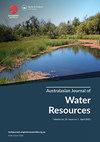旱地河流系统传输损失的动态和尺度:荟萃分析
IF 2.2
Q2 WATER RESOURCES
引用次数: 6
摘要
摘要本文综述了245项研究,以了解用于估计河道传输损失的方法。研究结果表明,回归方程、微分方程、流动路线、实验方法和水平衡是应用最广泛的。地理信息系统正在成为显示损失空间变异性的模型结果的方便框架。在美国,涉及控制排放的回归方程和实验方法被广泛用于评估传播损失,而在澳大利亚干旱地区,水平衡和流量路线方法很受欢迎。在非洲和亚洲,回归方程和水平衡是估计输电损失的常用方法。通过对世界不同干旱地区研究的数据进行回归方程,观察到输电损失量与河段长度、流入量、流量贡献面积和径流系数之间存在统计学意义(p<0.05)的关系。总的来说,该综述强调了河道和集水区特征在形成输电损失动态方面的重要性。目前方法的两个主要局限性是,它们针对特定地点,并且由于监测站网络稀疏,需要大量的数据,而干旱地区并不总是可用的。审查还强调了现有的知识差距和未来的研究需求。本文章由计算机程序翻译,如有差异,请以英文原文为准。
Dynamics and scales of transmission losses in dryland river systems: a meta-analysis
ABSTRACT In this paper, 245 studies were reviewed to understand approaches used for estimating river channel transmission losses. Findings indicate that regression equations, differential equations, flow routing, experimental approaches and water balances are most widely used. Geographic Information Systems are becoming a convenient framework to display model results showing spatial variability of losses. In the United States, regression equations and experimental approaches involving controlled releases are widely used to assess transmission losses whereas in the dryland regions of Australia, water balance and flow routing approaches are popular. In Africa and Asia, regression equations and water balances are common approaches to estimate transmission losses. By using regression equations on data pooled from studies done in different dryland regions of the world, statistically significant (p<0.05) relationships were observed between transmission loss volume and, reach length, inflow, flow contributing area and runoff coefficient. Overall, the review underscores the importance of channel and catchment characteristics in shaping the dynamics of transmission losses. Two main limitations of the current approaches are that they are site-specific and require high amounts of data not always available in dryland regions due to sparse network of monitoring stations. The review also highlights existing knowledge gaps and future research needs.
求助全文
通过发布文献求助,成功后即可免费获取论文全文。
去求助
来源期刊

Australasian Journal of Water Resources
WATER RESOURCES-
CiteScore
5.10
自引率
21.90%
发文量
25
期刊介绍:
The Australasian Journal of Water Resources ( AJWR) is a multi-disciplinary regional journal dedicated to scholarship, professional practice and discussion on water resources planning, management and policy. Its primary geographic focus is on Australia, New Zealand and the Pacific Islands. Papers from outside this region will also be welcomed if they contribute to an understanding of water resources issues in the region. Such contributions could be due to innovations applicable to the Australasian water community, or where clear linkages between studies in other parts of the world are linked to important issues or water planning, management, development and policy challenges in Australasia. These could include papers on global issues where Australasian impacts are clearly identified.
 求助内容:
求助内容: 应助结果提醒方式:
应助结果提醒方式:


